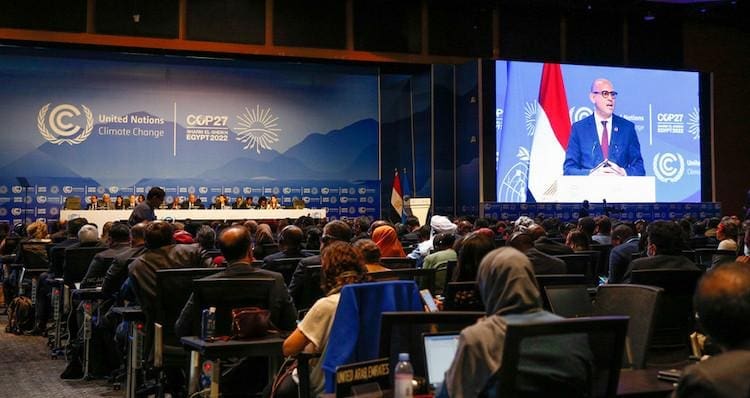Photo: Liquified Natural Gas export facility near Houston, Texas – Freeport LNG
The world needs to produce more electricity to meet energy consumption needs AND reduce greenhouse gas emissions. We know what we need to do: stop putting carbon dioxide into the atmosphere, take some of the carbon emissions that are already in the atmosphere out, and generate at least 2 times more electricity by 2050. We can do all three — at the same time. Climate change prevention and U.S. energy independence are not mutually exclusive objectives.
Unfortunately, because conflict sells advertising on television and garners clicks on social media, the conversation around how to fight climate change and energy independence is defined by the fringes—extreme environmentalists versus climate deniers. This is a dangerous choice. The question we should be asking ourselves is how we maximize human advancement while sustaining harmony with our home.
Energy Consumption is Not Decreasing – Billions Still Need Lights
Photo: Aerial image of Juba, the capital of South Sudan. In 2020, more than 92.7% of the population of South Sudan did not have regular access to electricity.
In 2022, the number of people around the world who live without electricity actually increased by 20 million people. Nearly 775 million people around the world are living without electricity.
The International Energy Agency (IEA), an intergovernmental organization recognized as a leading authority on real-world solutions to help countries ensure reliable, affordable, and clean energy for their citizens, has been tracking this statistic since 1974. The year 2022 was the first time there was an increase in the number of people without electricity rather than a decrease.
The pandemic, inflation, the global energy crisis and poor reactions by governments to these complicated problems have set back global progress on universal access to electricity. The World Energy Outlook 2022 report projects that 2022 was an anomaly, because they believe the number of people without electricity will decrease to 660 million by 2030. However, this means that 8% of the global population will still be without access to electricity by the end of the decade. We can do better than 8%.
A Lack of Diverse Energy Production Makes Basic Things Like Clean Cooking Impossible

Photo: A woman prepares a meal over a three-stone fire in India – Global Alliance for Clean Cookstoves.
According to the World Health Organization (WHO), 2.4 billion people still lack access to clean cooking. This means one third of the global population cook with dirty fuels like dung and coal, burned on open fires or in traditional stoves.
Burning dung in open fires or traditional stoves releases harmful pollutants like carbon monoxide and particulate matter. These pollutants can cause severe respiratory illnesses, leading to premature deaths among women and children who spend the most time in close proximity to these cooking methods.
The inability to access clean cooking is a serious issue, but it is also symptomatic of a larger problem — the lack of diverse energy production in many developing countries. This limitation not only impacts basic human needs like cooking, but it also hampers economic development, limits access to education, and perpetuates a cycle of poverty.
Energy Consumption in the United States is Increasing — We Need More Electricity, Not Less

Photo: Charging Station for Electric vehicles in Fort Stockton, Texas (Pop. 8,423) – PlugShare
The American population will increase total energy consumption by as much as 15% from 2022 to 2050. This prediction by The U.S. Energy Information Administration (EIA), an independent statistical and analytical agency within the U.S. Department of Energy, shows how as the population grows and the economy expands, the requirement for energy in various sectors such as transportation, industry, and residential use will also rise.
A big driver of this increase in energy consumption is the future need for more electricity. The average American spends 2% of their monthly income on their electricity bill. Many think tanks and several academic institutions predict that electricity consumption in the U.S. will more than double by 2050.
This necessitates a focus on innovative energy solutions, infrastructure upgrades, and new policies that prioritize energy efficiency and conservation measures. The transition to cleaner and more sustainable energy sources, such as solar, wind, nuclear, and hydroelectric power, will be crucial in meeting these escalating energy needs while minimizing our carbon footprint.
Energy Independent Means Having An Energy Policy Focused On Being Reliable, Affordable, Clean, Secure, and Based On The Realities of Today
The U.S. is the world leader in lowering carbon emissions – reducing emissions more than the next 7 countries combined. However, as Washington Post reporter Harry Stevens explained in a recent article, “In a future where global warming is more mild than catastrophic, we will need to change how we make electricity.” Making electricity without emitting carbon dioxide is hard.
Don’t Let What Happened to Semiconductors Happen to Solar Panels and Wind Turbines

Photo: An image of Tellurium, a rare earth element used in the production of solar cells.
Starting in 2020, solar energy and wind energy represented about 10% of American power generation. While the administration of President Joe Biden is seeking to rapidly shift to deploying and utilizing more solar panels, electric vehicles, and wind turbines, they have failed to develop a comprehensive strategy to shore up the U.S. supply chain for the parts and critical rare earth minerals needed for these technologies.
Approximately 80% of solar panels are made in China. In 2019, 90% of the world’s rare earth metals, alloys, and permanent magnets — critical elements in the solar and wind energy supply chain — were produced by China. Additionally, 85% of the world’s rare earth oxides that are necessary for the production of wind turbines, solar panels, electric vehicles and energy storage were produced in China. On top of that, China is a major import source for 11 critical minerals and Russia is a major import source for two of the critical minerals that the U.S. is 100% import reliant on.
Global demand for minerals is on the rise and production could increase by nearly 500% for graphite, lithium, and cobalt by 2050 to meet the growing demand for clean energy technologies. A recent study concluded the world has enough rare earth minerals and other critical raw materials to switch from fossil fuels to renewable energy to produce electricity and limit global warming. While we can mine for these materials without worsening the environment, much more mining is needed.
Despite this, the Biden administration imposed a 20-year moratorium on mining in 225,000 acres of northern Minnesota. Northern Minnesota alone is home to 95% of America’s nickel, almost 90% of America’s cobalt, 75% of America’s platinum, and more than one-third of our nickel. Rather than relying on foreign adversaries like China, we should be mining these resources here at home under the strongest labor and environmental standards in the world.
We Can’t Ignore Nuclear

Photo: A tweet from Benji Backer, the President of the American Conservation Coalition
The top six states with clean energy are powered primarily by nuclear or hydropower. Any serious efforts to reduce emissions from energy production to address the effects of climate change must include the continued use and expansion of nuclear power. Not only is nuclear power an affordable and reliable energy source, it’s also emissions-free.
Fission nuclear power provides 52 percent of America’s clean energy. Because nuclear power plants operate at full capacity more than 92 percent of the time, it has become our country’s most reliable energy source.
Despite these enormous benefits, some Democrats have worked to prevent the expansion of this robust source of carbon dioxide free energy. We’ve seen what can happen in countries like Germany where they have shut down nuclear plants—leading to the reopening of coal plants and an extreme reliance on needing to import energy in the form of natural gas from Russia.
We shouldn’t be building fission nuclear power plants the way we did in 1951. Modular reactors are part of a promising new generation of advanced reactors that are smaller, cheaper to build, and more easily deployable than traditional large nuclear power plants.
Additionally, advances in fusion offer a potentially limitless, clean, and safe source of nuclear energy, fusion has the potential to revolutionize energy production with minimal environmental impact and a reduced risk of nuclear proliferation. Investing in these advanced nuclear technologies will be instrumental in the revival of American energy dominance moving forward.
Promote Carbon Capture

Photo: Graphic from Labtag Blog on how carbon capture works – George Vaniotis Ph.D.
Between 2005 and 2018, replacing coal with natural gas drove a larger reduction in carbon dioxide emissions than replacing coal with zero-carbon sources like wind and solar. Abundant natural gas deserves much of the credit for weaning the United States off coal and we can further its expansion.
While extreme environmentalists have waged a war on American domestic production of energy, they are ignoring the fact that global demand for natural gas is expected to increase by 40% by 2050. Who supplies that demand matters. America must increase energy exports to displace dirtier Russian energy in the market and provide our allies with affordable, reliable, and cleaner energy. Similarly, an abrupt halt to domestic crude oil production would jeopardize energy independence, increase reliance on crude oil imports from foreign adversaries, and negatively impact the economy.
Banishing gas production in the U.S. and stopping crude oil exports won’t eliminate carbon emissions, because those greenhouse gases will be produced somewhere else. So will the jobs, economic growth, and geopolitical leverage.
We should also be looking at ways to promote carbon capture alongside the use of natural gas by expanding its use in power generation and in industrial processes. Additionally, we need to develop infrastructure for CO2 storage and promote the utilization of captured CO2 into useful products such as building materials.
Retool Diplomacy to be a Net Exporter of Clean Energy

Photo: Image from COP27 (Conference of the Parties 27), the annual United Nations climate change conference where nations gather to discuss, negotiate, and implement global strategies to address climate change and its impacts – UN Climate Change (Nov 2022)
The United States’ domestic efforts alone cannot prevent the devastating impacts of rising temperatures, wildfires, droughts, and rising sea levels. Developed countries have contributed the most to historic greenhouse gas emissions, but today, developing nations are responsible for over half of annual emissions and represent the largest source of emissions growth.
The U.S. has been the world leader in lowering carbon emissions while China is the world’s largest emitter, producing more annual carbon dioxide emissions than almost all OECD nations combined. On top of that, under China’s pledge in the Paris Agreement, they can grow their emissions about another 50% until around 2030.
The intersection of energy markets and world peace is often overlooked by climate activists. Diplomacy must prioritize the development and export of clean technologies to combat the rising emissions of developing nations and ensure global cooperation. However, this burgeoning industry based on a clean energy economy may also fuel a divide between wealthy nations and developing countries.
To mitigate this risk and propel progress, the U.S. must boost exports of clean technologies to become a global manufacturing hub. This shift in energy technology exports can be achieved through increased investment in research and development, as well as policies that prioritize the sale of these innovations. Only through innovation can we lower the cost of energy while reducing emissions. If we are to export our solutions around the world, particularly to developing nations, they have to be affordable and competitive with conventional options. Additionally, we need to increase clean technology exports to economically compete with the Chinese government.
It is time for diplomacy to align with clean energy exports to effect true global change and secure a sustainable future for all.
We Need The Earth, Not the Other Way Around

We need to reframe the conversation around climate change. It’s not a matter of “protecting the Earth.” Mother Nature is not going to lose a fight. Dealing with climate change is about humans changing our behaviors to prevent a response from Mother Nature that will ruin us. Mother Nature is undefeated.
We can maximize human advancement while sustaining harmony with our home. We can address the fact that millions need electricity and billions need basic things like clean cooking. We can meet the demand for increased electricity needs of the future while protecting our home.
We can do this if we pursue an energy policy that is reliable, affordable, clean, secure, and based on the realities of today. We can’t make the same mistakes with wind and solar power that we did with semiconductors. We can’t ignore the promise of nuclear energy. We must promote technologies like carbon capture, and we have to retool our diplomacy to ensure America becomes a net exporter of clean energy.
The Earth will keep spinning on its axis and circling the Sun. Our Earth is going to stay undefeated, because time is on her side, not ours. Planet Earth doesn’t need us. We need Planet Earth, and we must act like it everyday.
First time reading? If you want rational takes on foreign policy, politics and technology then sign up below or click here for “The Brief.” It’s a twice-a-month email on things that aren’t being discussed but should – all in 5 minutes or less.































